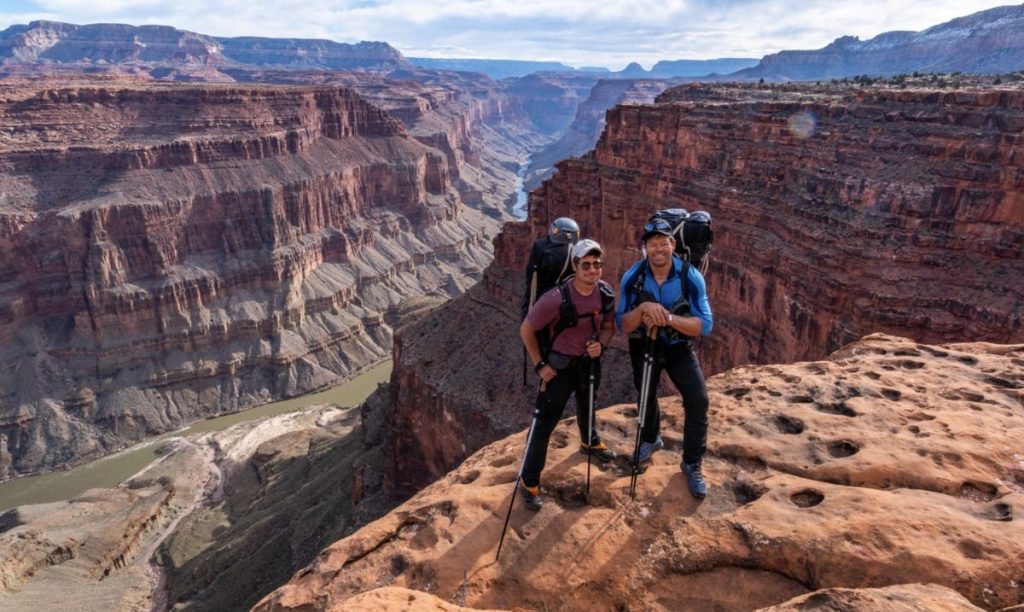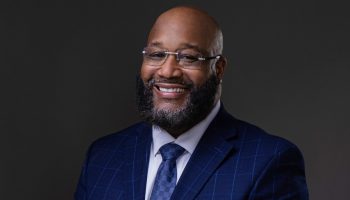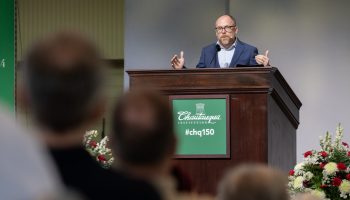
Zoe Kolenovsky
Staff writer
Using thrilling adventure stories as a means to draw attention to pressing conservation issues has long been a strategy of journalist Kevin Fedarko and photographer Pete McBride.
This was their goal in 2016, when the two men embarked on a journey to hike the entire length of the Grand Canyon in order to discover the greatest challenges faced by the region.
“I blame Pete because so much of that project was incredibly difficult and utterly miserable,” joked Fedarko.
Fedarko and McBride will speak to the Chautauqua community about the trip at 10:45 a.m. today in the Amphitheater — an over 750-mile odyssey that earned them the designation of “Adventurers of the Year” by National Geographic.
“We wanted to do a project that would lure people in with an adventure, but also make people realize… (that) these are very challenged, iconic public spaces that need attention for conservation,” said McBride.
Following the experience, McBride produced “Into the Grand Canyon,” a feature-length documentary for the National Geographic Channel that was nominated for an Emmy in 2020. His book about the trip, Grand Canyon: Between River and Rim, was published in 2018 and subsequently won the National Outdoor Book Award.
“The Grand Canyon National Park was experiencing commercial development pressures, which were at the time — and still are to a degree — happening on all four points of the compass,” said McBride.
Among issues of water conservation, commodification through tourism and commercial development on the canyon’s rims, uranium mining stands out as a threat to the landscape that has drawn significant attention in the public sphere recently.
“It has an incredibly problematic past,” said Fedarko. “Most Americans are not aware of how many uranium claims there are inside and around Grand Canyon National Park, and even fewer Americans … understand the incredibly toxic legacy of uranium mining in the Four Corners region of the Southwest.”
This legacy began in the 1940s, when the region’s mining industry exploded to provide uranium as fuel for nuclear weapons. These mines were located near primarily Indigenous communities, leaving them to suffer deleterious health effects resulting from decades of exposure to the radiation.
“The toxic legacy of that era and those policies and the failure to protect communities from the adverse health effects of uranium mining is still very much an issue that is in the forefront of the minds of Native Americans, the Navajo in particular,” Fedarko said. “It’s one reason why people are particularly distrustful of uranium mining outfits, which claim to be able to mine safely and in a manner that’s controlled.”
Years of protesting by these tribal communities and various environmental groups has prompted the Biden administration to announce just last week that officials are considering designating a large tract of land near the canyon as a national monument in order to prevent it from being used for such mining.
McBride is on the board of the Grand Canyon Trust, one of the principal conservation groups for the park, which has been a key player in the lobbying process.
“This is a collaborative effort with Native communities, with tribal voices that have come forward,” he said. “If this actually happens, I think it’s long overdue.”
Fedarko said one of his biggest discoveries from the hiking trip was related to the unsettling history of Indigenous groups in the region, a history that presents as a stain on the pride America has for its national parks.
“(There are several) Native American communities whose ancestral lands either abut or lie directly inside of this incredibly iconic national park that we celebrate as a kind of crown jewel of what some people call America’s ‘best idea,’ our national park system,” he said. “But in the process of creating that (system) … we disenfranchised entire nations of people whose ancestral relationship with that land runs far deeper.”
He continued: “Every conservation issue, every threat to the landscape … is unfolding on land that either belongs now to the tribes as part of reservations that lie directly next to the canyon or lands that the tribes used to control and own before the national park was created.”
Chautauquans will learn more about this history and its implications for protecting the Grand Canyon during the lecture today, which presents both men with an opportunity to continue their work of raising awareness about conservation issues through storytelling.
“We live in a world where, sadly, there’s a lot of distraction and a lot of shortened attention spans,” McBride said. “But the stories we tell ourselves or believe are still the bedrock of how we make decisions and how we move forward. I think telling the story of national parks and public spaces and wilderness is more important than ever.”
Fedarko said while it is often hard to measure the direct effects his work has on preserving and protecting the landscapes he writes about, he had a particularly rewarding experience with his 2014 book, The Emerald Mile.
“Ostensibly, it’s a book about three men in a little wooden boat in an effort to set a speed record through the Grand Canyon in the summer of 1983 by using a historic flood as like a hydraulic slingshot to propel them through the Canyon,” he said. “But really what it was, was an extended, 400-page love letter from me to the hidden world of wooden boats and whitewater at the bottom of the canyon.”
The book ended up being adopted by a public school district in Durango, Colorado, as a reference text for teaching language, writing and science to the students.
“It’s been very heartening for me over the years to think that there might be some young people that have read the book and have had their thinking stimulated by ideas inside of it,” Fedarko said.
He is currently in the process of completing his second work, which tells the story of his trip through the Grand Canyon in 2016.
“For the kind of work that I do, which is longform narrative nonfiction storytelling that often uses adventure as a … subversive vehicle through which to freight abstract ideas about environmentalism, conservation, and nature — the impact that that can have tends to be much more subtle and takes a much longer time to be felt,” he said.
Both men underscored the importance of telling this story as one that has the potential to unite Americans in the common and necessary goal of protecting our lands.
“It doesn’t matter, blue or red. It’s bipartisan,” McBride said. “What we gain from nature and wilderness and national parks goes across all socioeconomic groups and ages. We all have an ability to connect to this. And we all need it more than ever, the power of the night sky, … the importance of wildlife corridors, of fresh water, of course, and clean air.”
He continued: “The Grand Canyon is iconic, it’s symbolic of all our public lands and national parks. … Every generation has to do their part to keep it going.”




